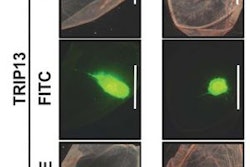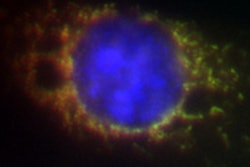A quartet of proteins that play critical roles in cell replication, cell death, and DNA repair could lead to better targets for therapy against head and neck squamous cell cancers that are resistant to treatment, according to a study presented at this week's American Association for Cancer Research meeting in San Diego.
U.S. researchers showed a correlation between the expression levels of the proteins in head and neck cancers (HNC) that are negative for human papillomavirus (HPV). These tumors have a poorer prognosis than HPV-positive HNC.
The cancers appear in the cells that line moist surfaces in the mouth, including the lips, tongue, and gums, as well as the throat, larynx, and sinuses. The National Cancer Institute reports that some 75% of these cancers are caused by tobacco and alcohol use -- and that use of the two together are a greater risk than use of either separately.
"The ultimate goal would be to better understand a tumor's protein signature and underlying biology so that, in the future, we can better understand treatments [that] are more likely to be beneficial to our patients with head and neck cancer," said presenter Ranee Mehra, MD, a medical oncologist at the Fox Chase Cancer Center in Philadelphia.
The researchers analyzed protein expression levels in samples from 101 cases of HNC banked from 1990 to 2002 in the Fox Chase tissue repository. One advantage of using this tissue is that samples are cross-referenced with patient treatment and survival data, Dr. Mehra said. Using tissue microarrays, which allow researchers to examine at a large number of samples at one time, the team looked for expression of ERCC-1, a DNA repair protein; survivin, a protein that inhibits programmed cell death or apoptosis; and two proteins active during cell division, Aurora A and phospho-Aurora A.
The research showed positive associations between expression of the repair protein ERCC1 and each cell-division protein, AuroraA (p < 0.0001) and phospho-Aurora (p = 0.0027). It also showed an association between both Aurora proteins (p < 0.0001). There was also an association between the apoptosis-regulator, survivin, and Aurora A (p = 0.0064), as well as survivin and ERCC1 (p = 0.0084).
A review of a database examining mRNA expression levels for the four proteins showed a highly significant correlation between Aurora A and survivin (p = 0.002), confirming the protein microarray findings.
Survivin expression may prove a marker for improved survival, especially in patients who were treated with surgery plus radiation, Dr. Mehra said. She found that tumors with less than a median level of survivin expression were associated with improved patient survival compared with tumors with more than a median level of survivin (p = 0.03).
ERCC1 is already a potential prognostic biomarker for survival among patients treated with radiation after surgery. In a study published in Clinical Cancer Research (December 1, 2013, Vol. 19:23, pp. 6633-6643), Dr. Mehra and colleagues found lower levels of ERCC1 predicted improved survival among patients treated with radiation.
"We hope to understand how these various pathways and mechanisms interrelate with each other," Dr. Mehra said. "Understanding those pathways would help guide future research."



















